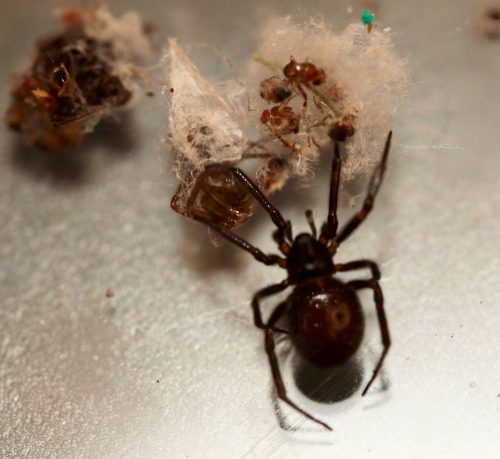“Ma’am, is that your husband in the sack of kitchen scraps and half-digested body parts?”
Not a happy morning — that Steatoda borealis I paired up earlier is no longer a pair. I guess she got a hungry.
Well, this is a bother. That was my last adult male — I’ve got about two dozen juvenies growing up in the incubator — and this has been a chronic problem. Every winter, all the spiders start eating less, lose all interest in sex, and stop laying eggs, despite my efforts at fooling them with temperature and a July-like light schedule. Last summer I’d come in an find fresh egg sacs every day; this winter, they dry up and even start dying.
I guess this just means I really have to do the bulk of my research in the summer…or maybe I’ll have to spend the winter trying to figure out how wild spiders survive the cold.



Honestly this seems like a significant finding, even if it wasn’t part of a formal study.
Maybe you need to set up a longer term study tracking the seasonality of mate consumption? I mean, funny but not actually a joke.
This explains why spiders were never considered as economically useful for producing silk as silkworms. Different creatures those lot.
I’m curious how they can see through your charade of fancy lights and heaters. Do they have some kind of internal seasonal clock?
could it be a humidity issue?
I think even CO2 has seasonal changes, so there are a lot of variables to check.
Yes, Humidity is my next concern. I’ve got all the adults in the open air of the lab on heating pads, and the building AC just sucks all the moisture out of the air. I’ve got a few tricks to try, though.
It’s the Christmas music this time of year, that’ll kill anything and put them off sex.
Is it just the scheduling of the light, or are you mimicking the UV content as well?
Do they overwinter as eggs or in some other dormant form as some bee species do? There’s a Golden Pea Bee (trichocolletes venustus) in our local national park and elsewhere but particularly our national park where our local bushcare volunteer group has planted as special native “garden” for them that is only visible and only has adults flying around fro a few weeks in sping when certain local natioves notably Daviesia genus plants are flowering. I guess that’s an extreme case ( I am NOT an entomologist) but :
Source : https://blog.growingillawarranatives.org/2018/03/gardening-to-attract-native-bees.html
(My google fu failed me in finding info I’ve been told in person FWIW.)
I’d guess there are already papers and studies and survey’s of spider numbers including Steatoda borealis over the course of a year but I could be wrong again, IANAE.
@9 Erlend Meyer : I think even CO2 has seasonal changes, so there are a lot of variables to check.
Yes, CO2 levels do vary seasonally see :
https://climate.nasa.gov/climate_resources/152/video-seasonal-changes-in-carbon-dioxide/
Something we humans via Global Overheating are also changing making Spring Greening arrive earlier :
Source : https://cires.colorado.edu/outreach/sites/default/files/2020-03/Climate%20Resiliency%20HS5%20-%20StudentActivityGuideRef3.pdf
As well as them rising constantly as can be tracked on the excellent updated Co2 now / Earth’s Co2 page here :
https://www.co2.earth/
Note that the seasonality of CO2 is mainly in the Northern Hemisphere (see StevoR’s post above). That is because there is much less landmass in the Southern Hemisphere to respond to changes in amount of daylight. So if it is indeed CO2 concentration changes that PZ’s spiders are sensitive to, perhaps instead raising spiders in the lab that are native to the Southern Hemisphere (where they didn’t evolve with this seasonal signal) could make a difference. Either that or maintain a lot of evergreen plants in the lab over the winter.